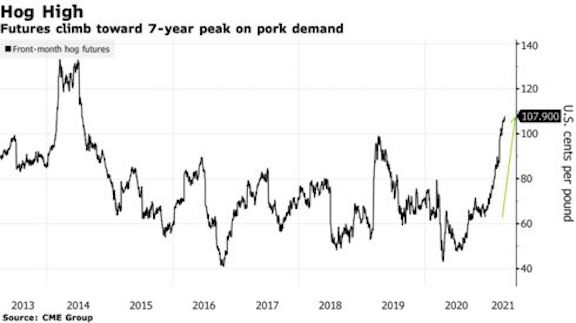Rising pork demand drives US hog prices to highest since 2014
Lean hogs, one of this year’s best-performing commodities, are fetching the highest U.S. prices since 2014 as pork-pricing changes in the Philippines lift demand prospects.
The Philippines ended a two-month ceiling on pork prices and the U.S. industry is already anticipating reduced tariff rates on imports of the meat. The measures come as the Southeast Asian nation battles an outbreak of the deadly African swine fever virus, which has also had a resurgence in top pork-producing China.

The Philippines is one of the fastest-growing markets for U.S. pork, while China has become the world’s biggest importer since the outbreak of swine disease in 2018. Demand for the meat is rising as businesses reopen in the U.S., a turnabout from last year’s diminished demand when restaurants closed in the early days of the pandemic.
“You have a rebound in demand, not just in Asia but here in the U.S. and, right now, the supply is not keeping up with it,” Altin Kalo, an analyst at Steiner Consulting Group in Manchester, New Hampshire, said in a phone interview.
Lean hog futures climbed as much as 2.3% to 108 cents a pound, the highest since July 2014. Year-to-date gains of more than 50% has hogs outperforming other big gainers, including gasoline and copper futures.
The Philippines would sharply reduce import tariffs for pork, providing more access to foreign supplies, the National Pork Producers Council said Wednesday in a statement.
“With global pork supplies remaining limited this year, these reductions in import duties will help improve availability in the Philippines and provide further momentum for U.S. exports,” U.S. Meat Export Federation spokesman Joe Schuele said in an email.
Similar Stories

U.S. international trade in goods and services, November 2024
View Article
Mexico announces increased tariffs on apparel imports, forcing a “scramble” to reshore operations in the United States
View ArticleCPA applauds Biden Administration action to block Nippon Steel’s purchase of U.S. Steel
The Coalition for a Prosperous America (CPA) commends President Biden’s decisive action to block Nippon Steel’s $14.9 billion bid to acquire U.S. Steel. This decision reflects a necessary commitment to…
View Article
Avocados will continue strong surge in 2025 and beyond
View Article
Forecast 2025: A welcome economic rebound
View ArticleU.S. International Investment Position, 3rd Quarter 2024
The U.S. net international investment position, the difference between U.S. residents’ foreign financial assets and liabilities, was –$23.60 trillion at the end of the third quarter of 2024, according to…
View ArticleGet the most up-to-date trending news!
SubscribeIndustry updates and weekly newsletter direct to your inbox!





